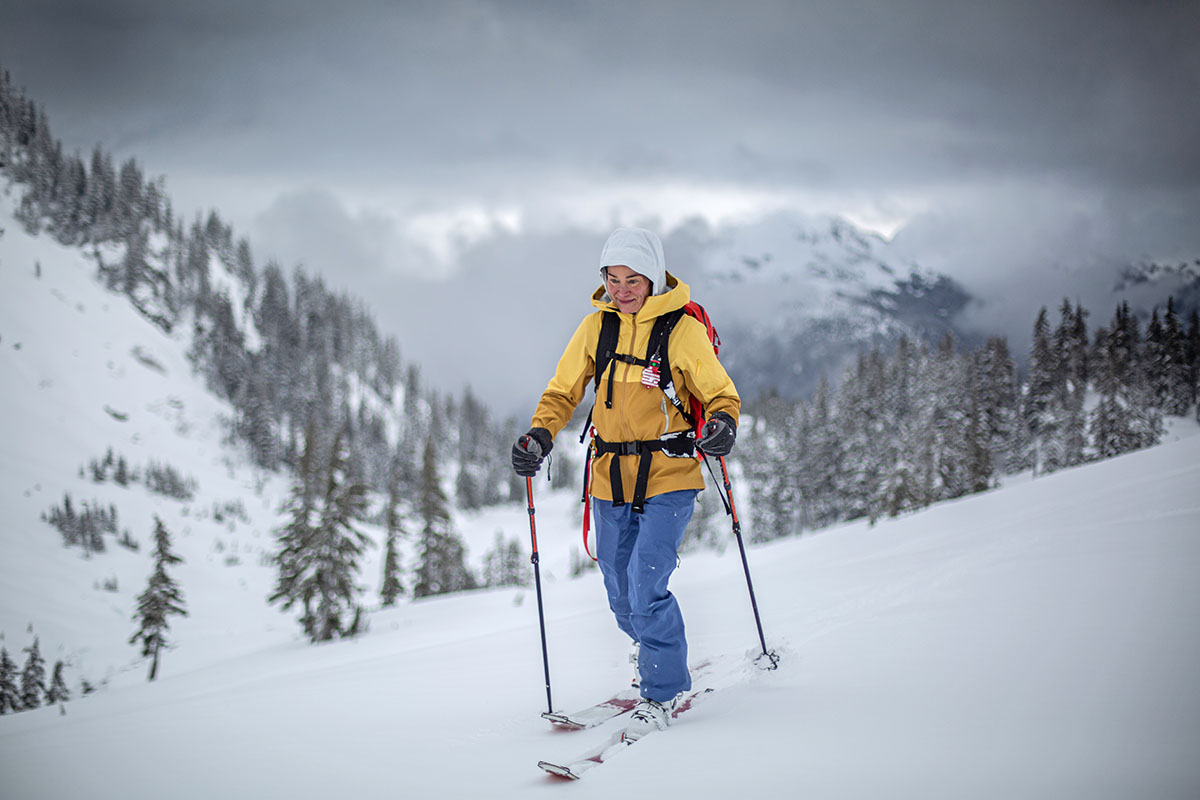
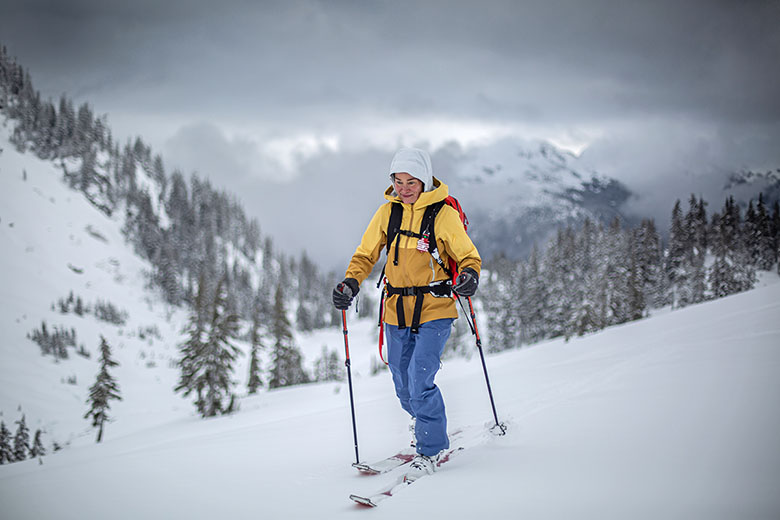
Price: $700
Weight: 1 lb. 4.4 oz. (women’s small)
Waterproofing: 3L Gore-Tex
What we like: Reliable protection, premium build quality, and more comfortable than most 3-layer hardshells.
What we don’t: Steep price tag; a little too heavy and bulky for dedicated backcountry use.
See the Women's Arc'teryx Sentinel Jacket
Arc’teryx is a leader in the premium ski shell market, and their flagship Sentinel (and men’s Sabre) is a standout for resort-goers and ski tourers alike. Previously called the Sentinel AR, the latest design is largely similar to its predecessor but has a slightly roomier fit for better mobility and easier layering. We put the Sentinel to the test both inbounds and in the backcountry, where it proved itself as a hardwearing and reliable shell in notoriously variable Pacific Northwest conditions. It’s no small investment at $700 and is a bit heavy and bulky for dedicated backcountry use, but the premium build and all-around performance are hard to beat. Below we outline our experience with the Sentinel Jacket. To see how it stacks up to the competition, see our articles on the best women’s ski jackets and best women's snowboard jackets.
The Arc’teryx Sentinel Jacket sports a burly 3-layer Gore-Tex construction with a durable water repellent (DWR) finish and taped seams, making it a very capable companion in gnarly weather. Throughout its testing, the Sentinel has confidently withstood a variety of conditions typical of coastal skiing: wet sleet, bitter cold, pelting snow, and strong wind. With the jacket’s hood cinched tightly and the high collar protecting my chin, I’ve remained remarkably dry and warm throughout testing. In fact, the Sentinel has quickly become my favorite ski shell due to its stalwart protection and battened-down feel. For resort and backcountry riders alike, it's a really trustworthy design.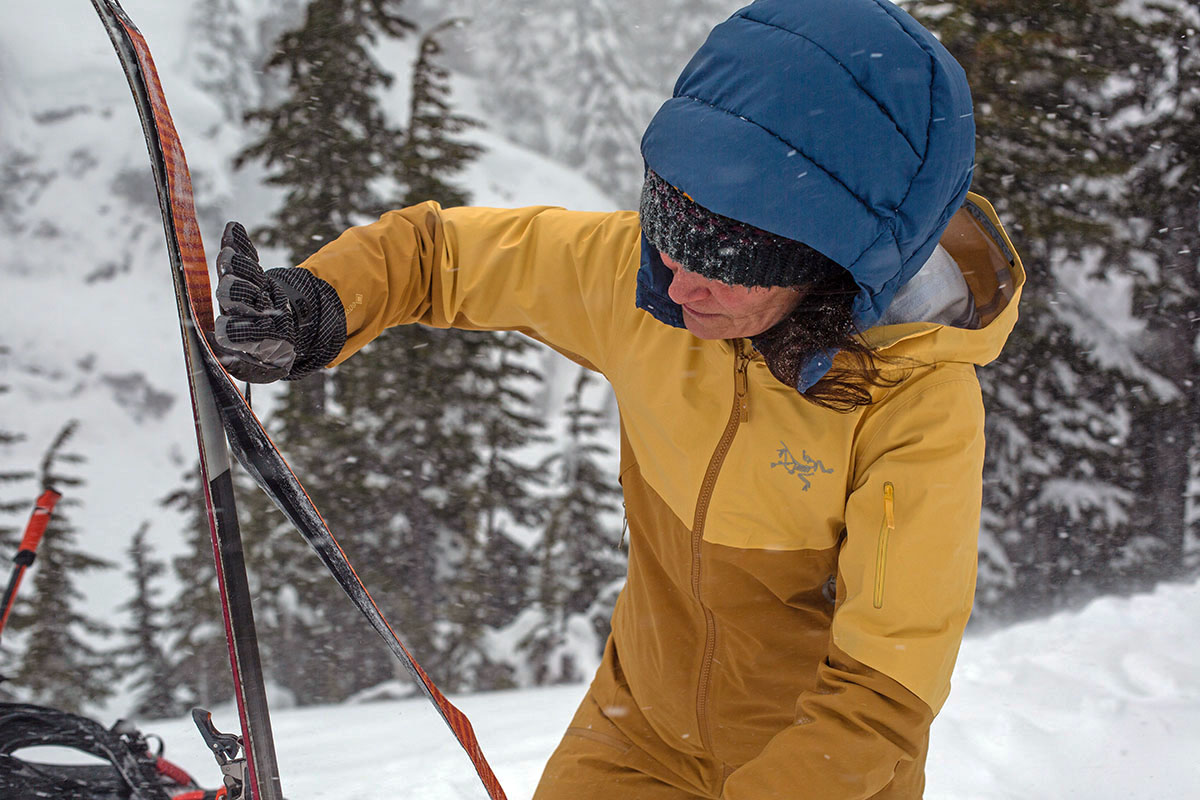
The rest of the Sentinel’s build is equally weather-worthy. The WaterTight zippers on the hand pockets effectively seal out moisture, the adjustable Velcro cuffs can be snugged under or over gloves, the 28.5-inch (72.4 cm) length provides great coverage, and the powder skirt easily attaches to compatible ski pants, including the corresponding Sentinel Pant or Sentinel Bib Pant. And even when the jacket isn’t attached to pants, the powder skirt is comfortable and stays put with the hem drawcord and rubberized elastic at the back. I sometimes paired the jacket with Patagonia’s PowSlayer Bibs (which only cover up to mid-torso) and had no issue with snow—or even wind—entering at waist.
The Sentinel Jacket stands out from other weather-worthy ski shells in one key area: comfort. Overall, the jacket offers excellent range of motion with no restriction to movement when transitioning or bending down to adjust boots or bindings. Arc’teryx also included a brushed flannel backer, which gives the interior a noticeably soft and supple feel against the skin—it’s a sizable upgrade from the crinkly and stiff feel common among traditional 3-layer hardshells. The backer also adds a modest dose of warmth, although the Sentinel is still breathable enough to pull double duty for touring (more on this below).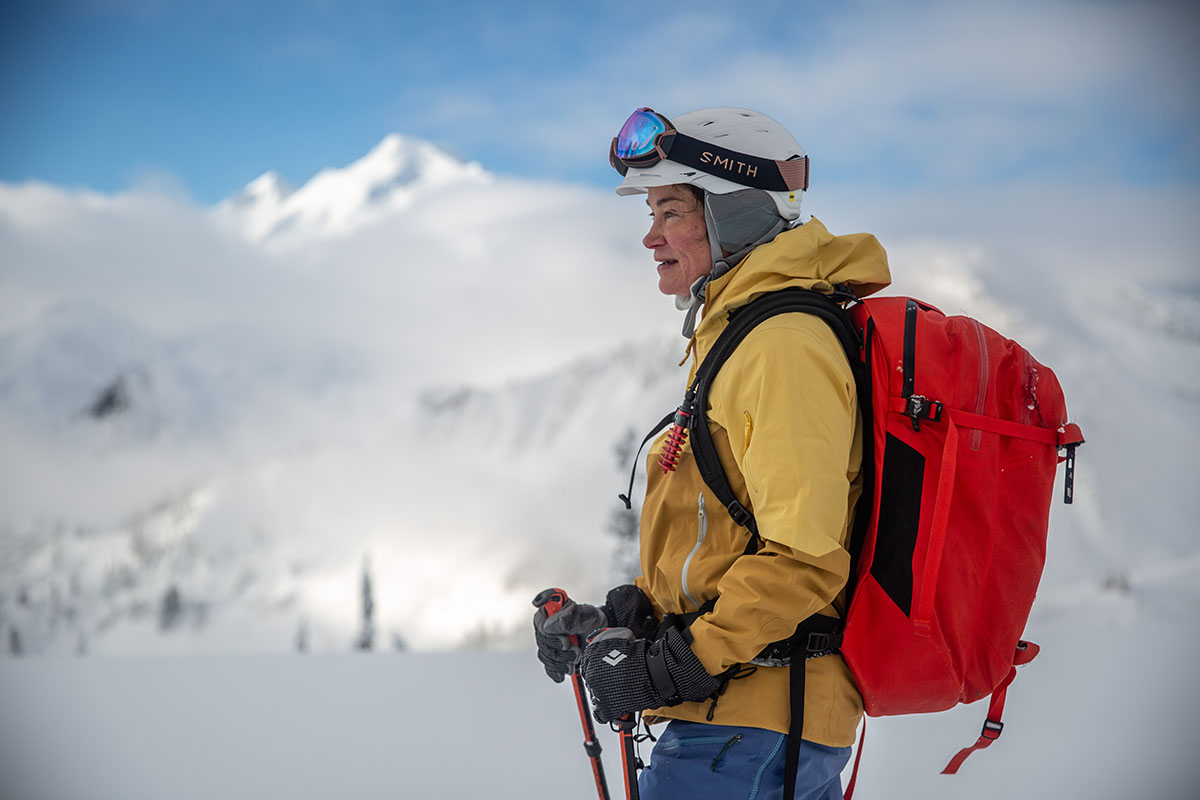
Overall, the Sentinel Jacket breathes well considering its 3-layer Gore-Tex build and light flannel backer. Like most of Arc’teryx’s backcountry-focused shells, it comes equipped with nicely sized pit zips for dumping heat quickly. These do require two hands to manipulate but are very effective at promoting airflow. The flannel backer mentioned above also feels cozy against the skin and isn’t prone to growing clammy during exertion, which is a notable advantage over most 3-layer shells. Those who run warm or tour exclusively will likely want to opt for an unlined design like the Patagonia SnowDrifter or Outdoor Research Skytour, but I personally love the versatility of the Sentinel.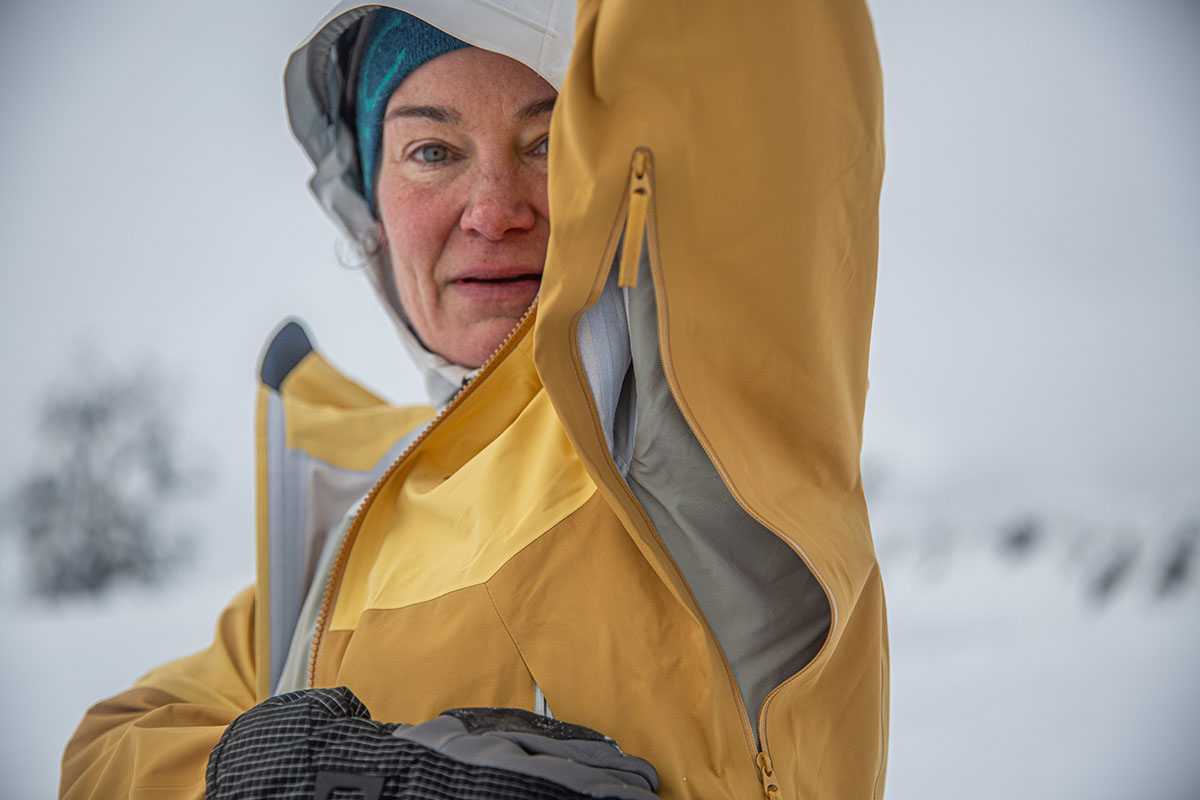
Durability has never been an issue with any Arc’teryx hardshell I’ve tested, and the Sentinel Jacket is no exception. First and foremost, the 70-denier (D) face fabric is noticeably robust and impressively resistant to tears and abrasion. Similar to the men’s counterpart (the Sabre) that my husband tested last winter, the Sentinel has a distinctively burly feel that gives me confidence in rough weather and when bushwhacking or scraping against branches and rocks. In fact, after months of frequent use, my jacket is holding up with no real signs of wear: The exterior continues to repel water, all of the seams are intact, and the zippers and hem/hood cinches are in perfect working order. Taken together, the Sentinel is another high-quality and hardwearing design from Arc’teryx that should last for many seasons to come.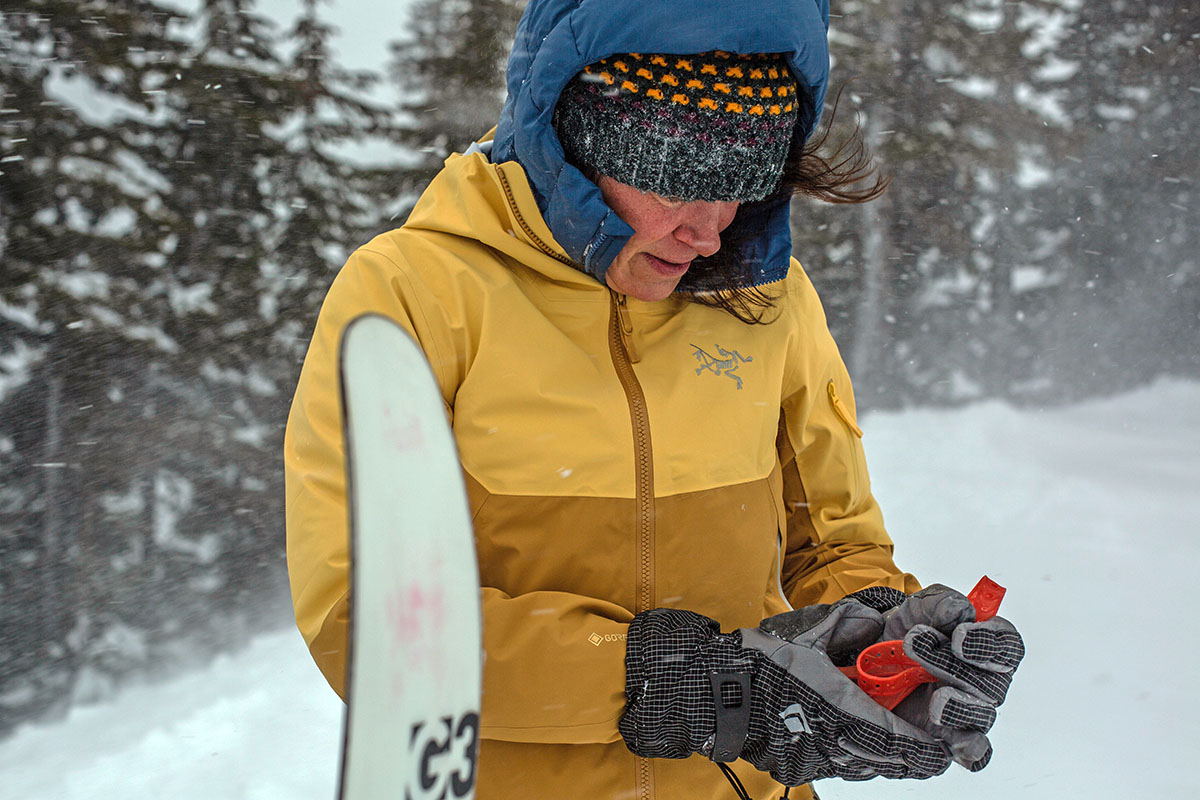
The Sentinel Jacket clocked in at 1 pound 4.4 ounces on my scale for a women’s size small, which is relatively heavy for the backcountry. It’s worth noting that Arc’teryx lists the weight much lower at 13.1 ounces, but we opted to use our own spec throughout this review since it feels more accurate given the jacket’s thick build and full feature set. For comparison, the Sentinel is lighter than many resort-specific designs but slightly outweighs most similarly intentioned 3-layer shells including the Outdoor Research Carbide (1 lb. 2.8 oz.) and Flylow Gear Lucy Jacket (1 lb. 3.5 oz.). And you can go even lighter with a non-ski-specific shell like Arc’teryx’s own Alpha SV (14.8 oz.), although you lose out on helpful features like a powder skirt and hand pockets. 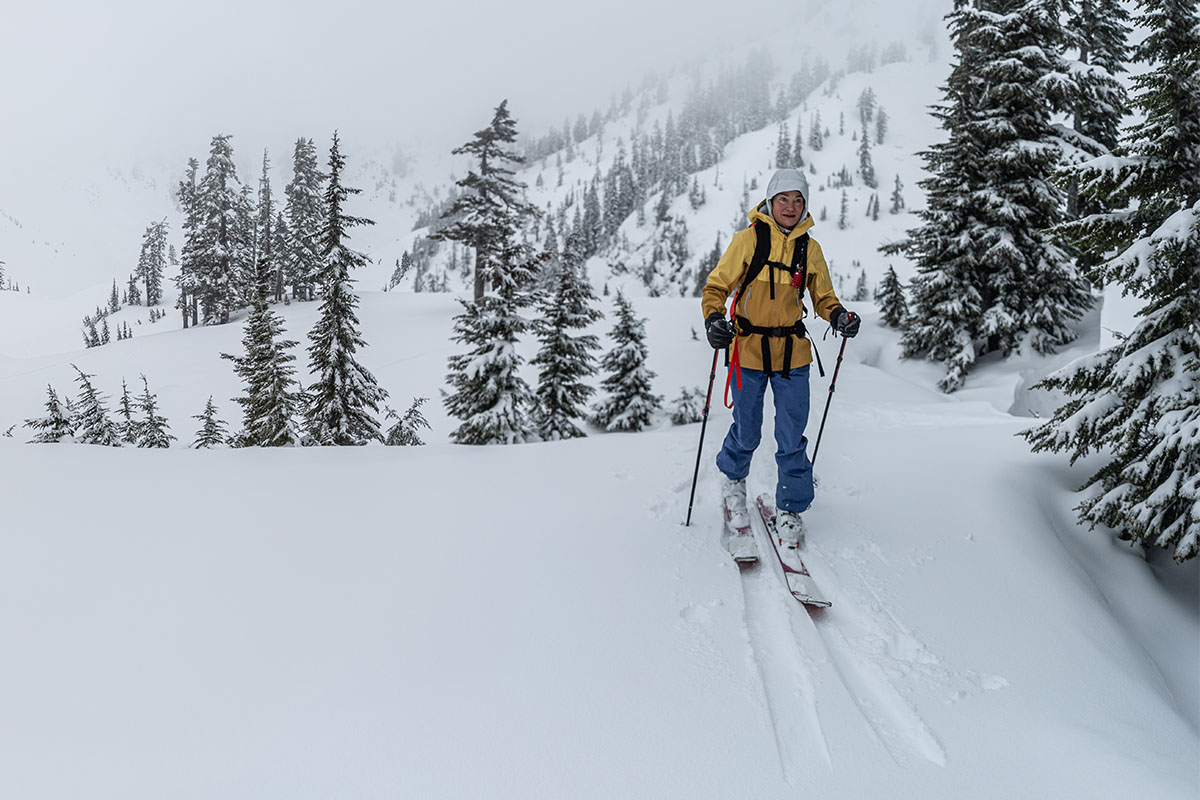
To be fair, the Sentinel still rolls and stuffs nicely into its own hood (it’s about the size of a cantaloupe when compressed), but it’s nevertheless a burly ski shell. In the end, I don’t mind shouldering the added weight on resort days and outings when warmth and weather protection matter most, but it’s not my first choice on long backcountry tours. On these missions, I’m inclined to opt for a lighter and more streamlined design like the aforementioned Alpha SV or Patagonia’s 1-pound-2-ounce SnowDrifter Jacket, although the latter is largely unavailable at the time of publishing.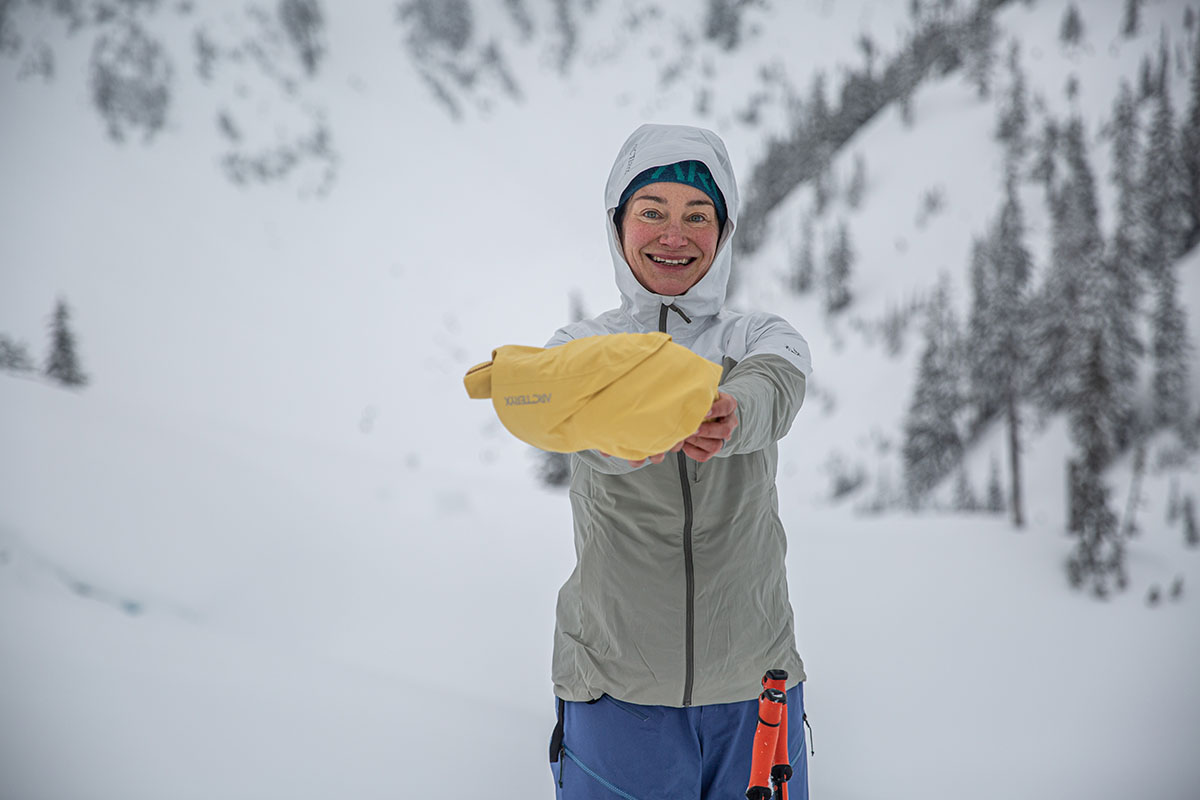
Arc’teryx’s helmet-compatible StormHood is our favorite design currently on the market: It offers full coverage, is easily adjustable, and stays put when snugged down. It’s also large enough to comfortably fit over my ski helmet (the Smith Valence) without any restriction to vision or movement—I even paired it with both a beanie and the hood of my down jacket on a particularly cold outing without issue (other than the obviously bulky look). Additionally, the laminated brim effectively prevents moisture from dripping onto my face in heavy precipitation, and the entire hood can be cinched tight using three drawcords: two at the front and one at the back. When snugged down, the aperture leaves only my nose and goggles exposed to the elements.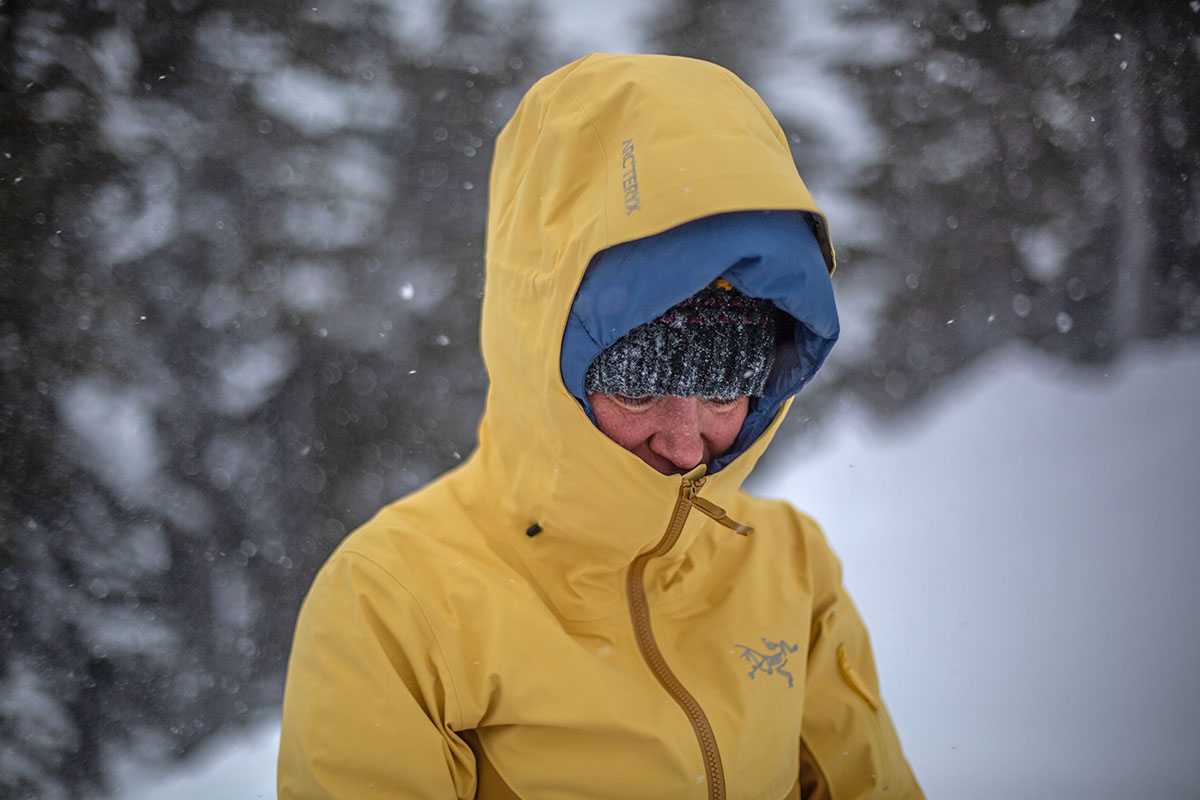
The Arc’teryx Sentinel Jacket features five total pockets, which was ample for keeping all of the essentials handy. This includes hand pockets, an arm pocket, an internal laminated pocket, and an internal (non-zippered) mesh dump pocket. In terms of space, the interior dump pocket is a good spot to stow ski goggles or gloves but is a bit too snug for skins, the laminated pocket easily swallows a smartphone, and the hand pockets are very generous and situated high enough on the waist to access while wearing a ski backpack or harness. Finally, the left bicep pocket is surprisingly large and has a flared interior to allow items to be stuffed inside without restriction. Truthfully, I haven’t found a great use for this space—our local hill’s ski pass scanner is at hip level, and the pocket is big enough that I have to fish around inside to find my pass. Arc’teryx also sewed a Recco reflector into this pocket, which adds a nice dose of security in the event of a backcountry emergency.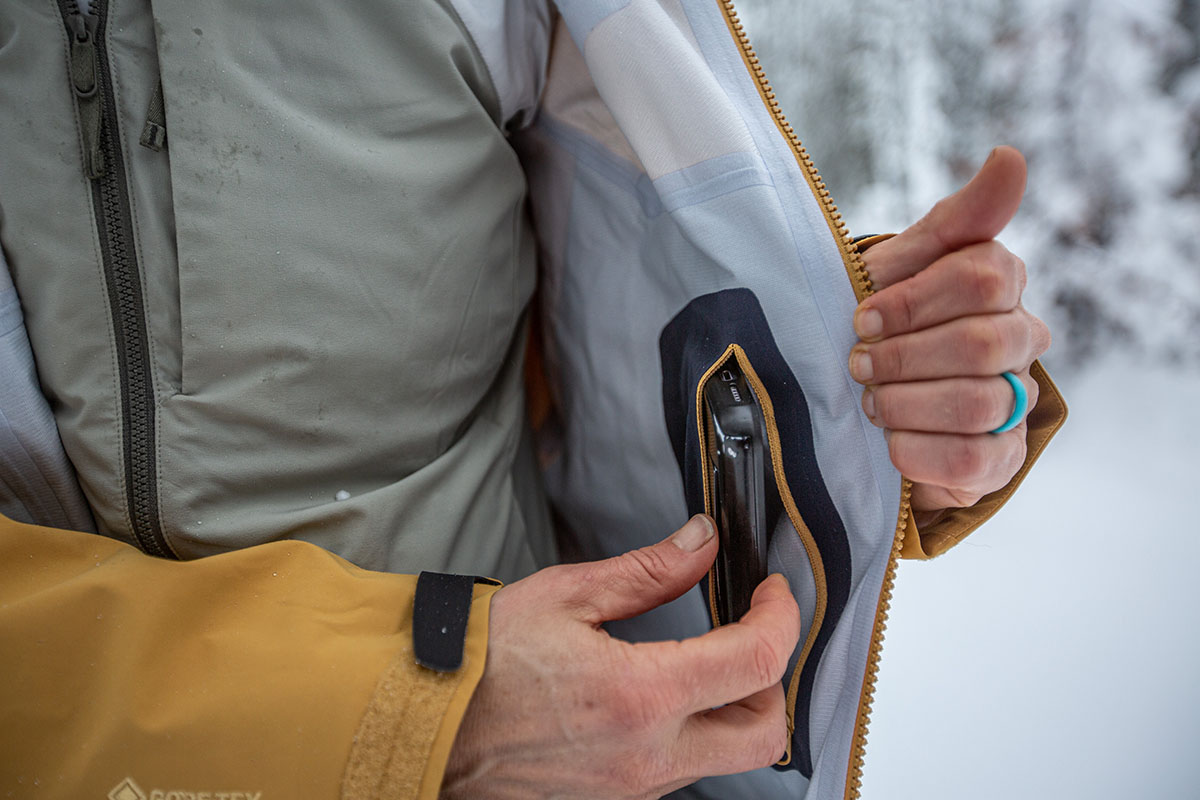
On the topic of storage, it’s worth noting that the hand pockets boast Arc’teryx’s WaterTight design mentioned above, which foregoes the protective “garage” typically found at the top of other zippers. This shaves a little weight and bulk and adds to the jacket’s sleek and streamlined exterior. Importantly, these are water-resistant and not fully waterproof, but I haven’t experienced any moisture seeping through—I trust them enough to store my phone regularly.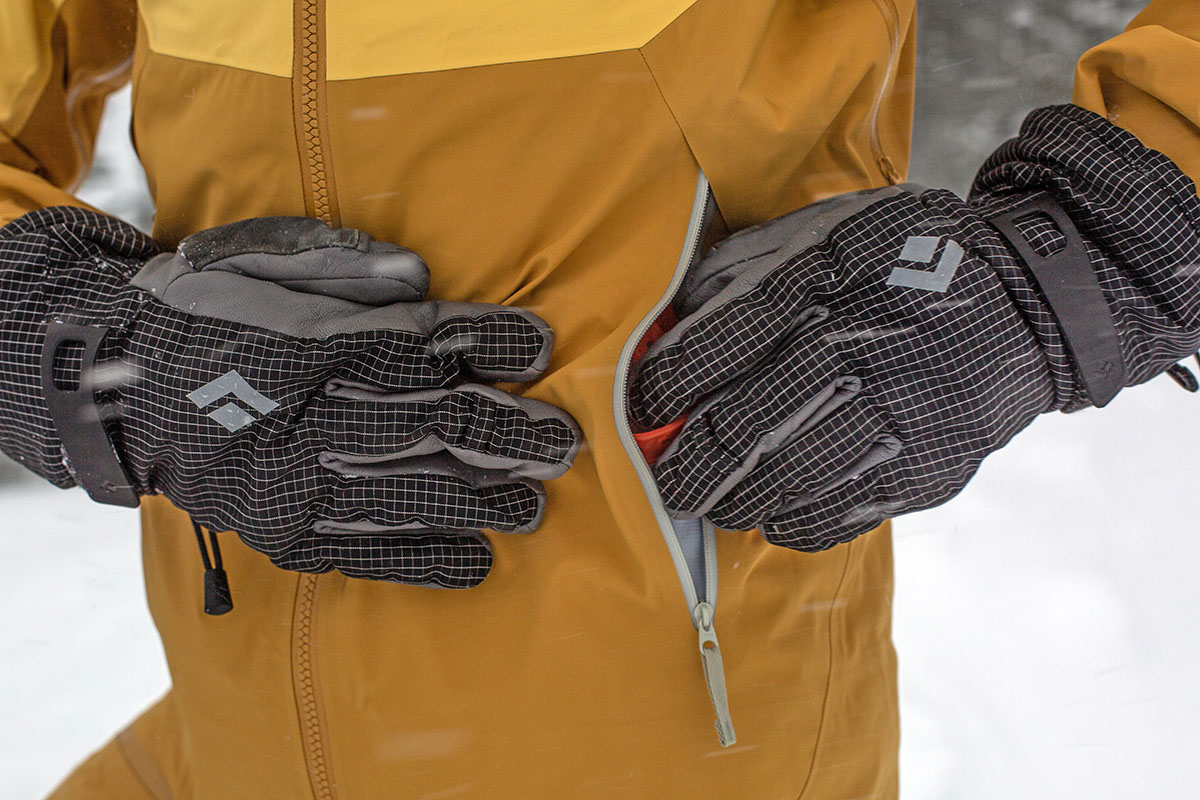
As I mentioned above, the Sentinel Jacket features an integrated powder skirt that attaches to compatible Arc’teryx pants with two Slide’n Loc closures below the waistband at the back. Paired with the matching Sentinel Bib Pant, the system has stayed securely attached while skiing without any issues. And if you don’t plan to pair the Sentinel with Arc’teryx snow pants, the powder skirt has a grippy elastic at the back that prevents it from flopping around. As I mentioned previously, I also wore the jacket with Patagonia PowSlayer Bibs on occasion and didn’t have any problems with riding up or snow making its way in at the waist.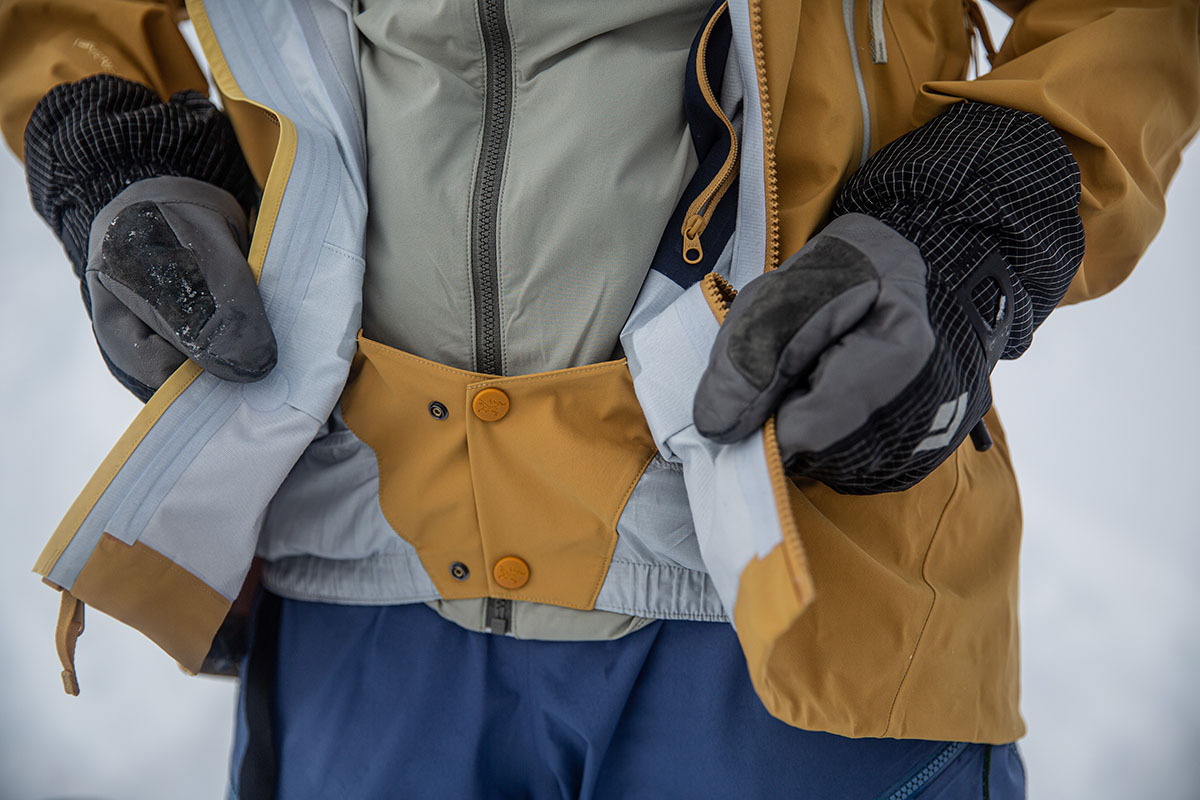
Arc’teryx recently revised the Sentinel Jacket’s fit with more room in the chest and waist to boost freedom of movement and make it easier to layer underneath. Overall, I felt that the “regular” cut was true to size: My typical women’s small was comfortable to layer under down jackets including the lightweight Arc’teryx Cerium Hoody and midweight Thorium Hoody, and the gusseted underarms and articulated elbows allowed for excellent mobility while transitioning or struggling up steep inclines. Finally, the 28.5-inch center back length is spot-on for my 5’8” frame, providing enough coverage for me to sit down on a cold chairlift or bend over to adjust boots and bindings without riding up above my waist.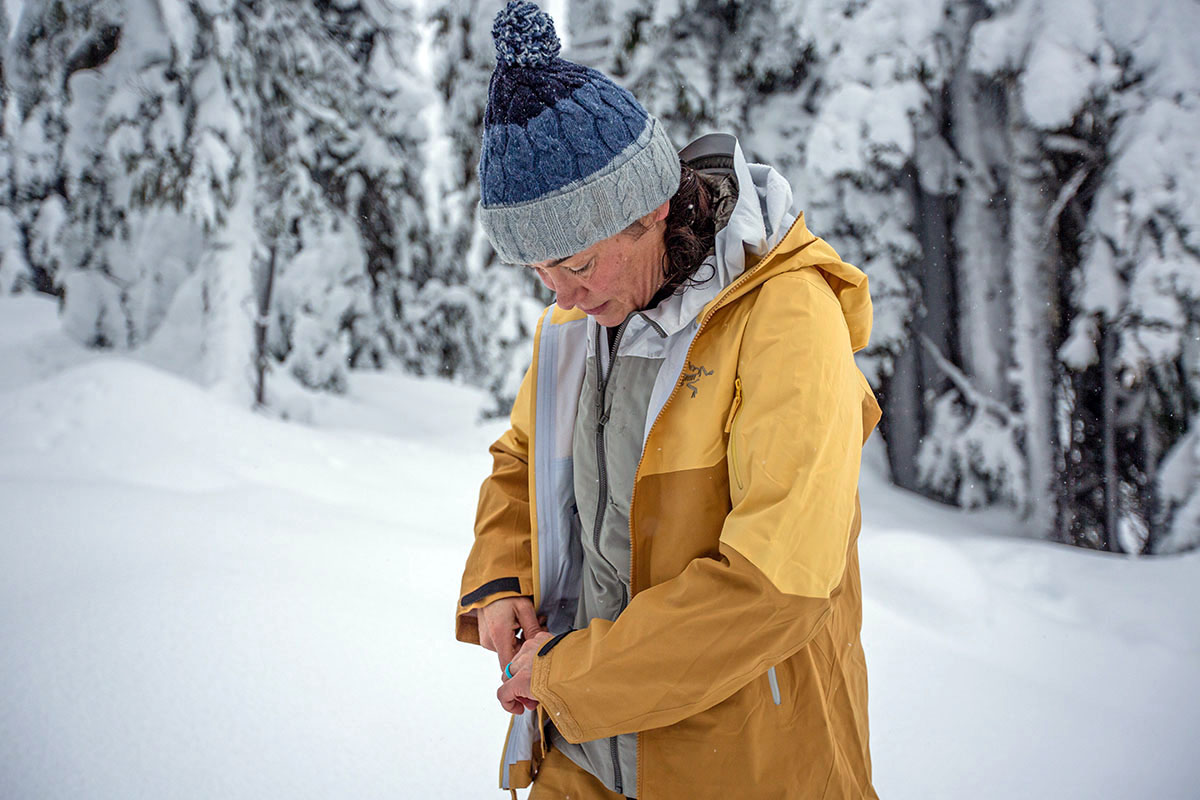
Arc’teryx has joined many other leading outdoor brands in the push for sustainability, and the latest Sentinel Jacket was produced in a Fair Trade Certified facility. This designation indicates that workers are getting compensated fairly, have access to safe working conditions, and are receiving additional funds for healthcare and community initiatives. Arc’teryx has pledged to expand this certification to at least 80% of their products by 2025, which is a commendable goal. 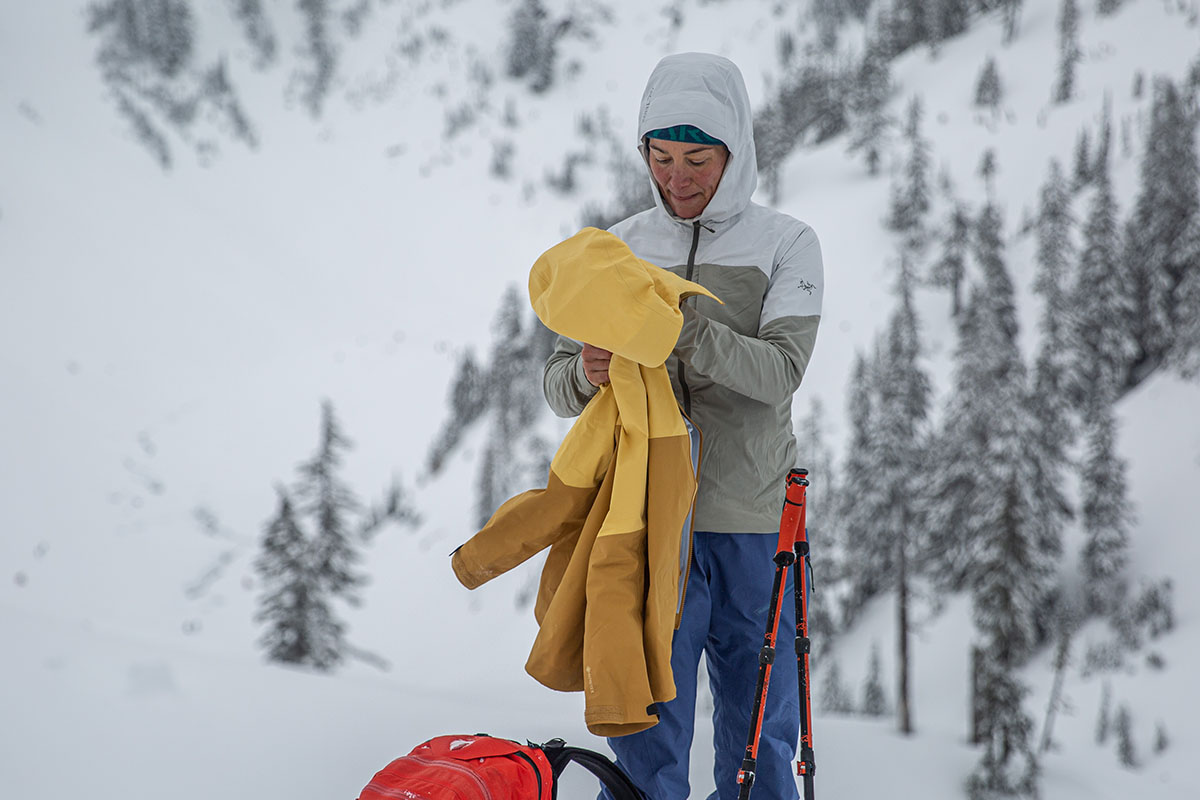
We put the women’s Sentinel Jacket to the test, and Arc’teryx sells the matching Sentinel Pant ($550) and Sentinel Bib Pant ($650). As we mentioned above, both the pants and bibs connect to the jacket via the handy attachment system on the powder skirt and boast a similar 3-layer Gore-Tex build (also 70D). Arc’teryx also sells the Sentinel Jacket in an anorak style, which is largely similar to the design tested here but with a different storage layout and pullover styling. Rounding out the women’s collection are the Sentinel Insulated Jacket ($800) and Sentinel One Piece ($1,200). The former utilizes 2-layer Gore-Tex with an 80D face fabric and 80-gram Coreloft insulation for added warmth on cold resort days, while the latter is a sleek single-piece design that offers full coverage for particularly deep powder days.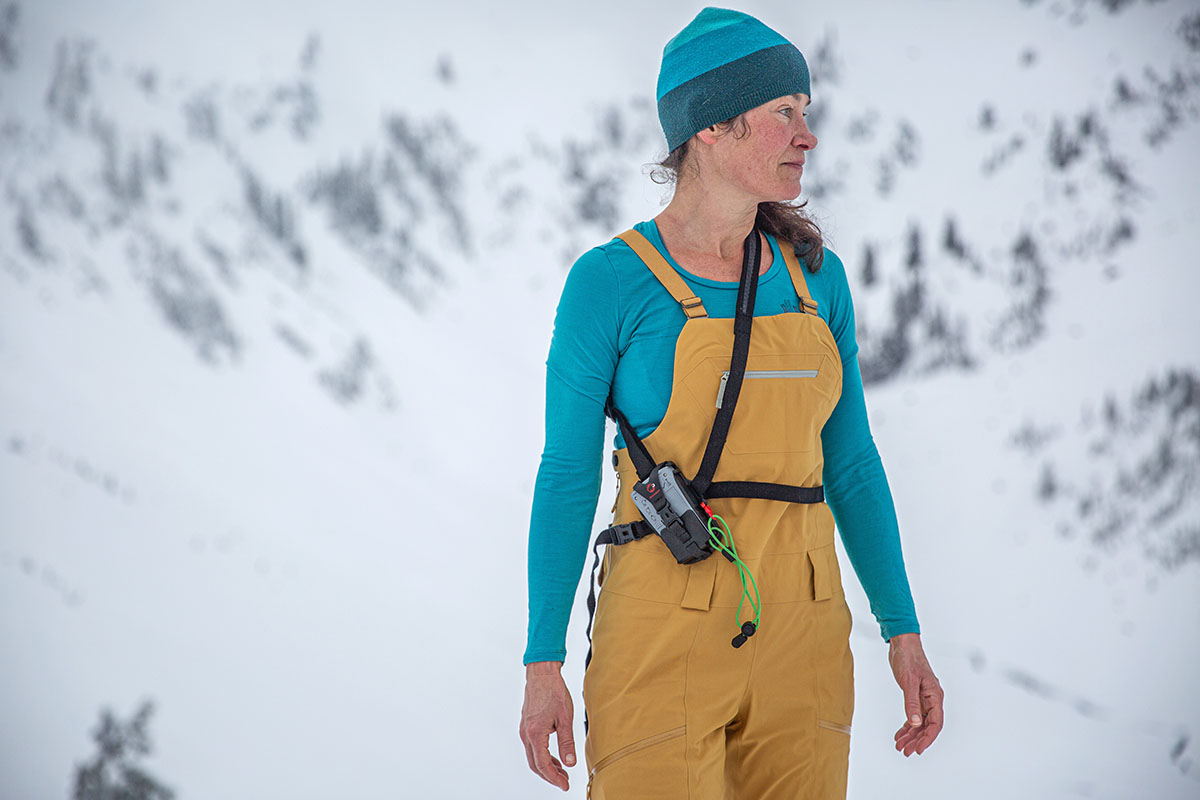
The men’s counterpart to the Sentinel is the Sabre, and the collection includes the Sabre Jacket, Sabre Pant, and Sabre Bib Pant. Overall performance lines up very similarly to the Sentinel offerings, although the Sabre uses thicker 80D Gore-Tex compared to 70D for the women’s jacket and pants. It’s worth noting that the Sabre Jacket is unavailable at the time of publishing, but we expect Arc’teryx to bring it back for the 2023-2024 ski season (in the meantime, you can check out our in-depth review from last season here).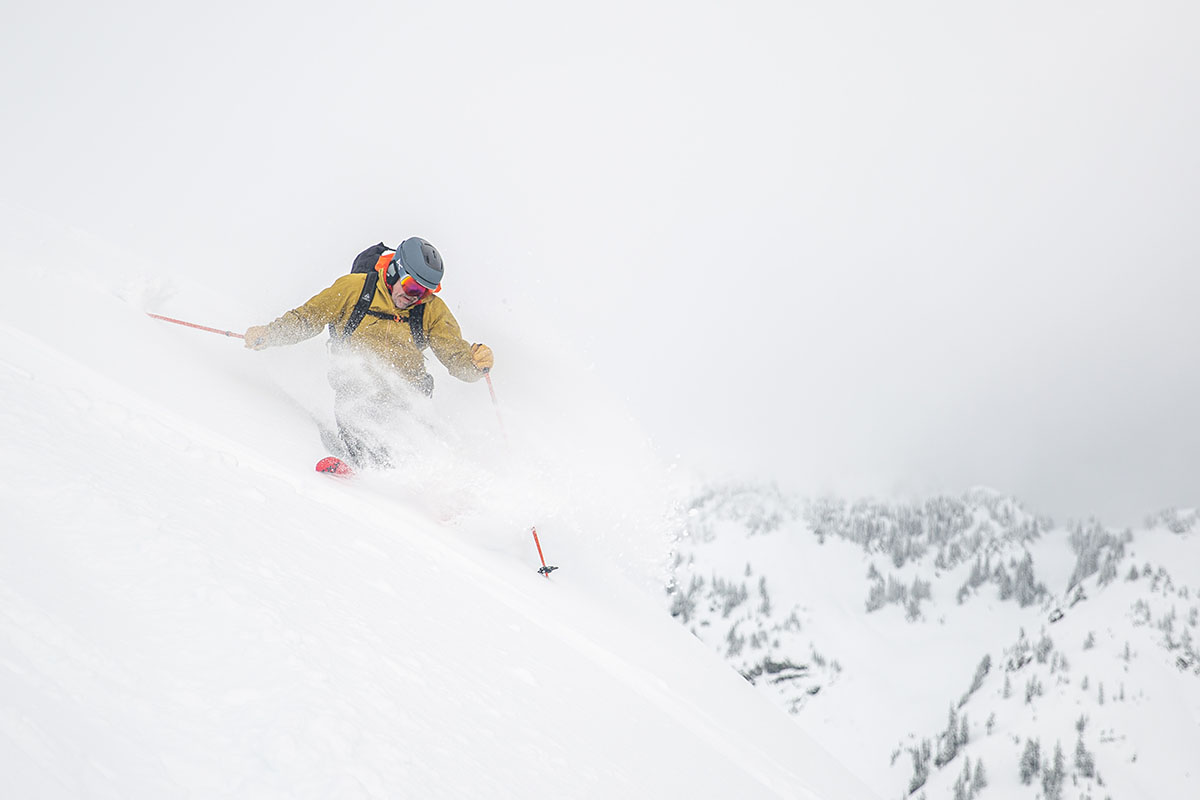
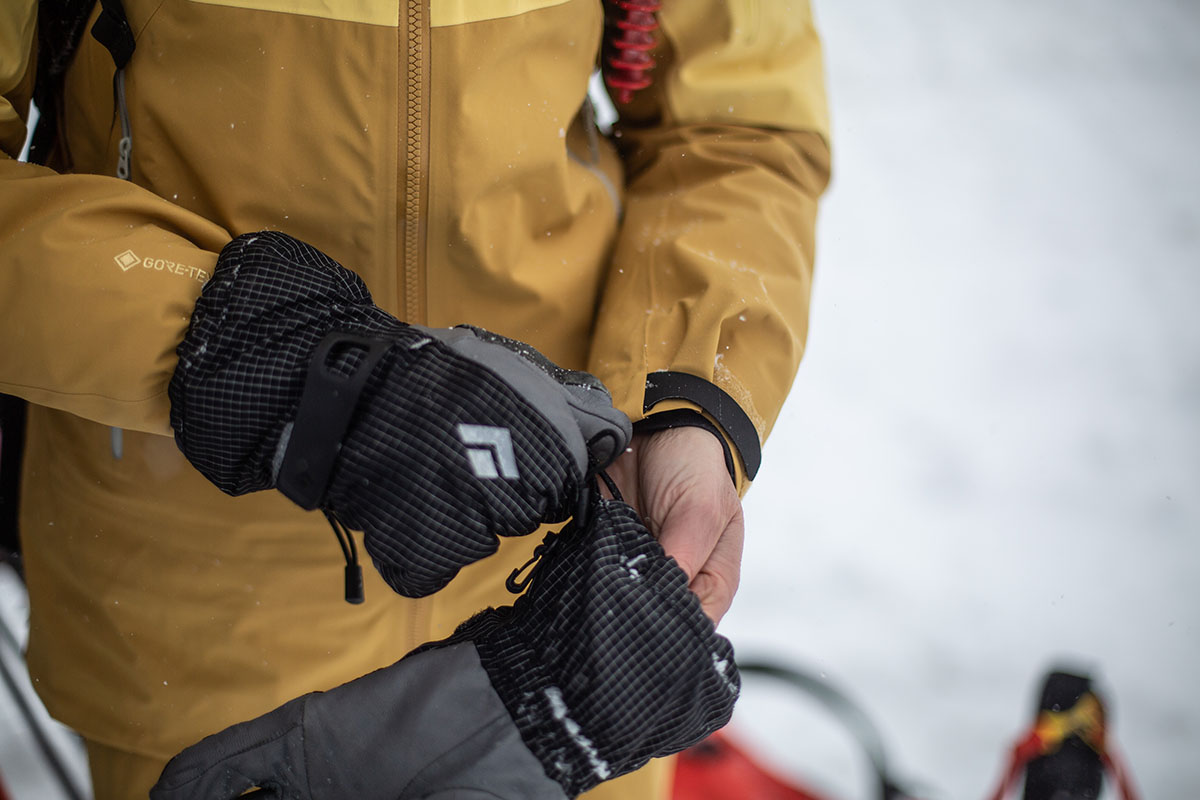
| Jacket | Price | Best For | Insulated | Waterproof | Weight | Recco |
|---|---|---|---|---|---|---|
| Arc'teryx Sentinel Jacket | $700 | Resort/backcountry | No (thin backer) | 3L Gore-Tex | 1 lb. 4.4 oz. | Yes |
| Flylow Gear Lucy Jacket | $400 | Backcountry/resort | No | 3L Tactic | 1 lb. 3.5 oz. | No |
| Trew Gear Stella Primo | $479 | Resort/backcountry | No | 3L PNW Primo | 1 lb. 9 oz. | Yes |
| Black Diamond Recon Stretch | $400 | Backcountry/resort | No | 3L BD.dry | 1 lb. 7.5 oz. | No |
| Outdoor Research Carbide | $299 | Backcountry/resort | No | 3L Pertex | 1 lb. 2.8 oz. | No |
The Arc’teryx Sentinel is our top-rated women's ski jacket for 2023 and one of the most well-rounded designs on the market, but there are plenty of alternatives to consider—many of which are considerably cheaper. The first is Flylow Gear’s Lucy Jacket, which retails for $300 less than the Arc’teryx. In this case, Flylow opted for an in-house material called Tactic, which is a 3-layer softshell fabric that provides a nice balance of comfort and weatherproofing. It’s a step down in all-out protection compared to the Sentinel’s proven Gore-Tex design, but the Lucy still has a reliable and battened-down feel thanks to the sealed seams, waterproof YKK zippers, a removable powder skirt, and an extended collar that covers all but your nose when zipped up. Committed riders who get out on stormy days in wet climates (like the PNW) will be better off with the Sentinel, but the Lucy nevertheless hits a nice middle ground of comfort and performance for mixed resort and backcountry use—all while looking great in the process.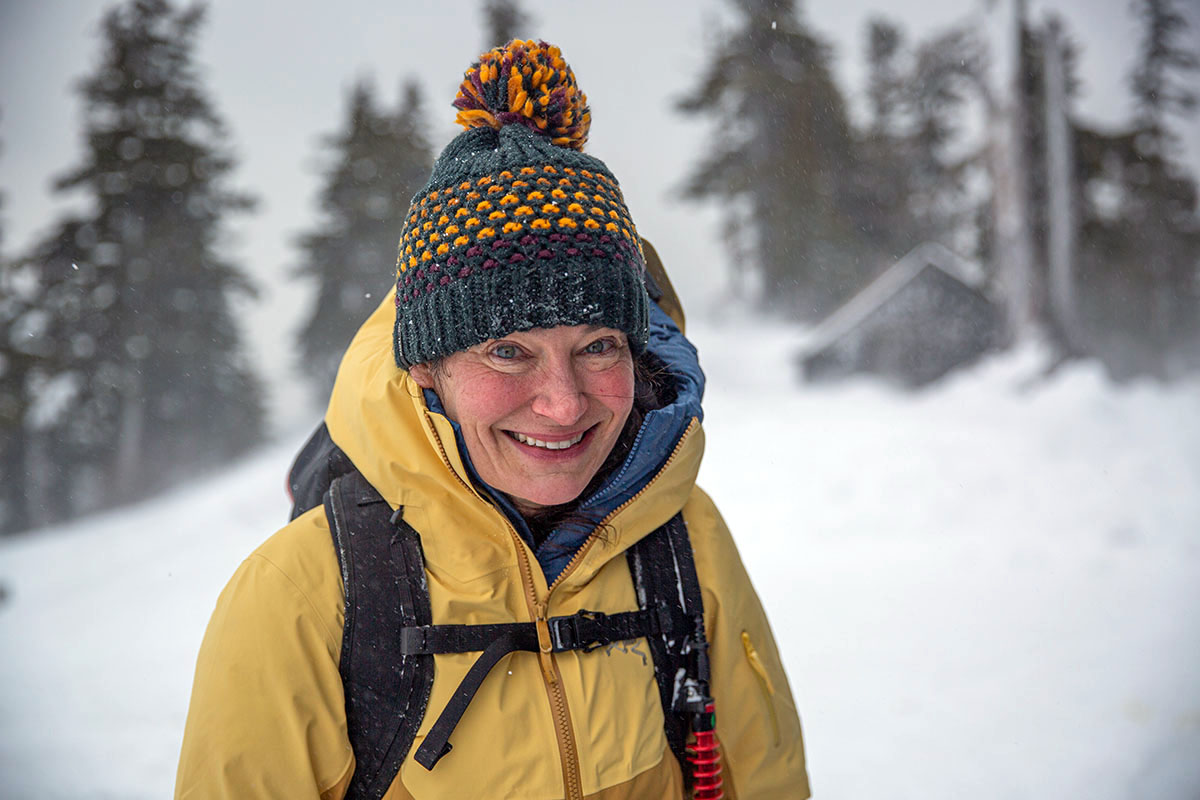
Next up is Trew Gear’s Stella Jacket Primo, which is another well-rounded option for skiers who split their time between in- and out-of-bounds use. Rather than Gore-Tex, Trew Gear opted for their proprietary 3-layer Primo membrane with a hardwearing woven shell. The design has a thick, almost softshell-like feel that moves with you and provides a nice mix of comfort, durability, and weatherproofing. That said, it also adds considerable weight and bulk: At 1 pound 9 ounces, the Stella is even heavier than the Sentinel and overkill for dedicated backcountry use. The flared cuffs are also fairly polarizing, and the Stella is overall less sleek and streamlined than the Sentinel. It will save you a significant $221, but the Arc’teryx’s premium looks and top-notch protection give it the overall edge in our rankings.
Black Diamond has quickly assembled a healthy lineup of both resort and backcountry-ready designs, and their Recon Stretch Shell is a nice all-rounder that excels both inside and outside of the ropes. The jacket combines the brand’s proprietary 3-layer BD.dry membrane with a four-way stretch shell, translating to full-on weather protection with little compromise in the way of comfort and mobility. Uphill enthusiasts will love the removable powder skirt and internal mesh drop pockets for storing their skins, while resort-goers will appreciate features like a lift pass pocket on the left arm and a ski helmet-compatible hood. That said, the Recon’s build quality and fit can’t quite measure up to Arc’teryx’s keen attention to detail, and weight jumps to 1 pound 7.5 ounces. The $300 price savings are undeniably enticing, but we consider the Sentinel to be the higher-quality and better-executed crossover design.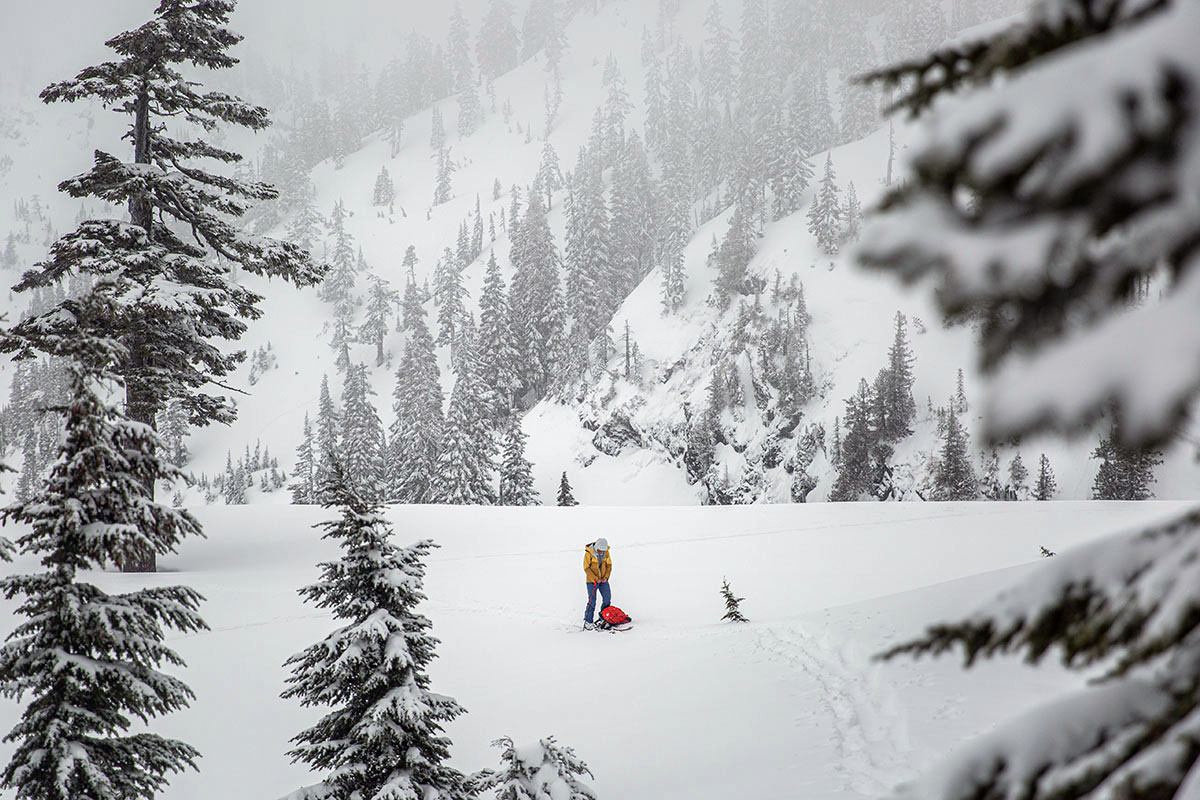
Last but not least is the most affordable alternative here: Outdoor Research’s $299 Carbide Jacket. Despite undercutting the Sentinel by a whopping $400, the Carbide stacks up very competitively: The 3-layer Pertex Shield waterproof membrane offers reliable protection in harsh weather, you get a tricot knit backer for added next-to-skin comfort, and the 29-inch back length provides solid coverage without impacting mobility. OR also retained a healthy feature set for resort use, including six total pockets (including one on the forearm), pit zips, a powder skirt, and a wire-brimmed hood that easily accommodates a ski helmet—all while managing to keep weight competitively low at 1 pound 2.8 ounces. We hesitate to recommend the Carbide as a dedicated resort design due to its relatively thin 40D face fabric, but if you spend most of your time in the backcountry and aren’t too hard on your gear, there’s a whole lot to like.
Editor’s note: We usually provide a live price comparison table below our outdoor gear reviews, but the Sentinel is currently only available directly through Arc'teryx. You can see the Sentinel Jacket page here and support us in the process. Thanks!